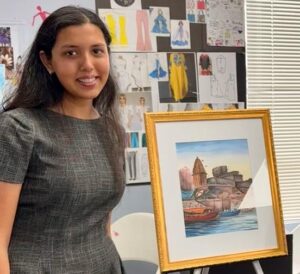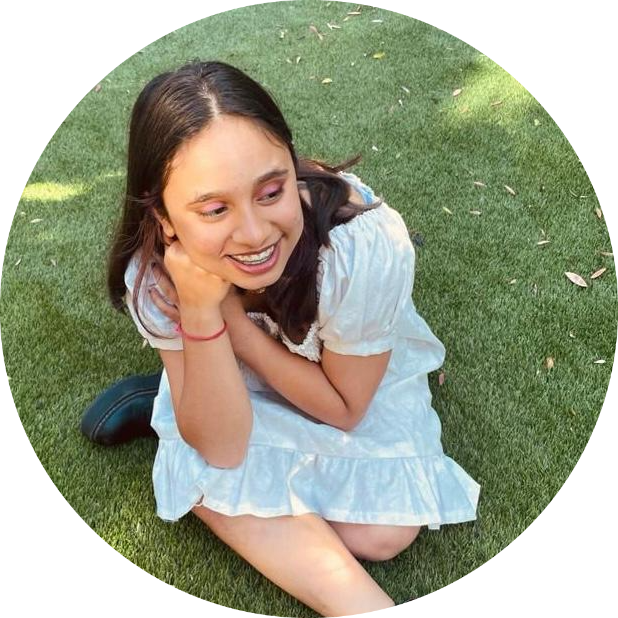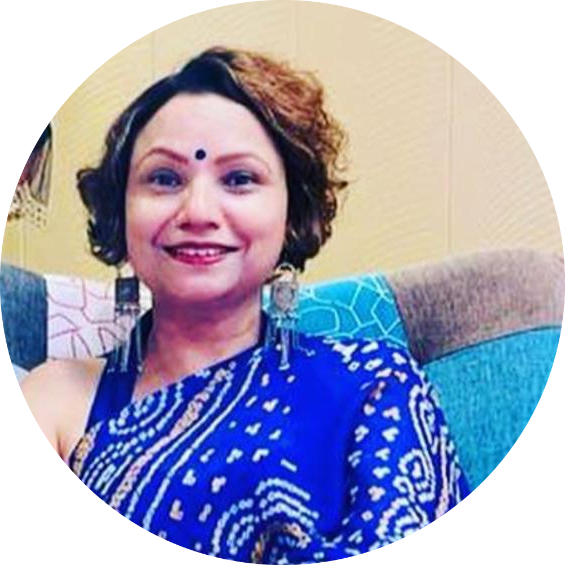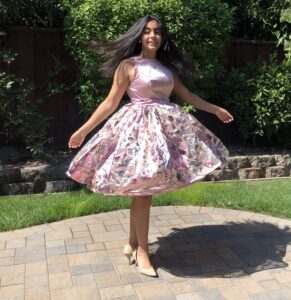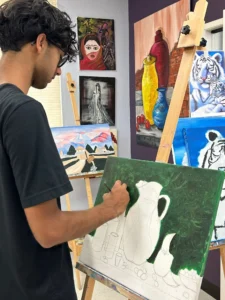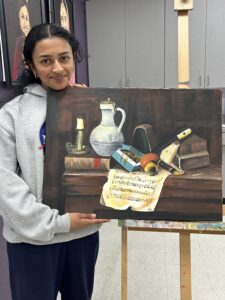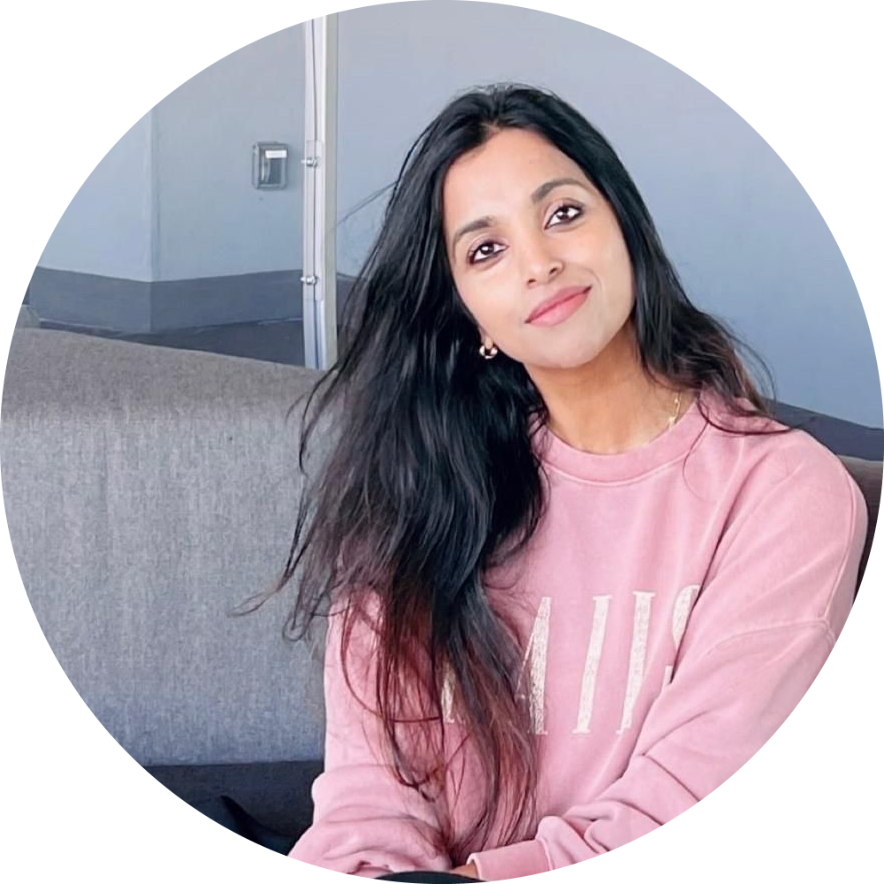Celebrating Colors with Mother Teresa
By Arjun Anand, Grade 8th Many people have heard of Mother Teresa. She was a nun who helped “the poorest of the poor.” She did so in Calcutta, India, for most of her life. Many admired her for her charitable work. The painting I made honors her, and the services she did in her lifetime. For this painting, I used Cubism as my main technique. Some famous cubist artists are Piet Mondrian and Salvador Dali. Cubism was prominent in the early 20th century, and it was pioneered by Pablo Picasso and Georges Braque. In cubist art, objects are analyzed and broken up and reassembled in an abstracted form. To me, cubism represents the idea that not everything is perfect and that they don’t have to be perfect to look good. In my drawing, I added many different colors to show uniqueness. I also added small details, such as earrings, which reminded me of my mom. To honor Mother Teresa, I drew blue stripes running across the drawing. The stripes represented the blue stripes on Mother Teresa’s sari. A sari is an article of traditional clothing that women wear in India. To do this drawing, I used many tools and techniques. I started off by penciling in the basic lines and shapes. To make my lines for my cubes straight, I used a ruler. Once I was done with that, I used a 0.1 black inking pen to ink the drawing. Now, the basic drawing was done, I just had to color the rest. To do that, I used Copic Brush Markers to color the drawing. I colored each square a different color. In the end, I was happy with the result.
Village Scene, Warli Art
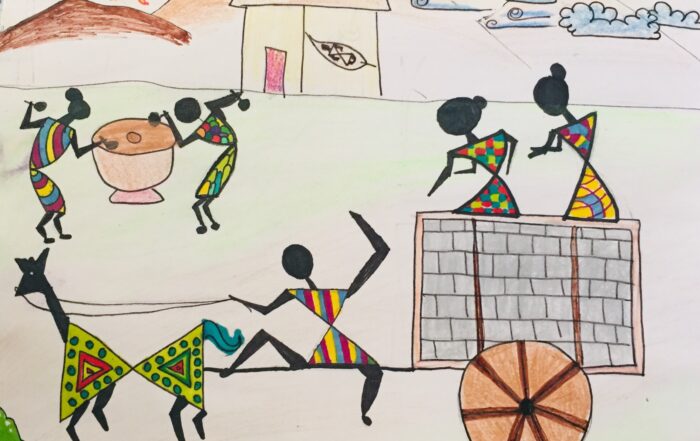
By, Minali Kancharla, Grade 7th The word Warli means a piece of land in the Varli language. Warli is a folk painting style native to India that mostly represents traditional everyday living and special events. The Warli style uses geometrical designs to make the main body of the subjects, this is for humans and animals. Warli painting uses basic shapes such as circles, triangles, and squares. The first step to this art is to sketch out your village scene using a set of basic shapes and make geometric patterns on the dresses. The page was then washed with tonal watercolor, to give a vintage effect. After the water wash on the page dries up, I outlined the sketch with a black point pen. The color scheme chosen for this artwork was Split complimentary, for this I chose two sets of split complementary colors. For each animal or human, use one set of complementary colors to fill the designs inside the subject. The end result is a colorful piece of art made from basic geometric shapes and colors.
Chaos in Oneself
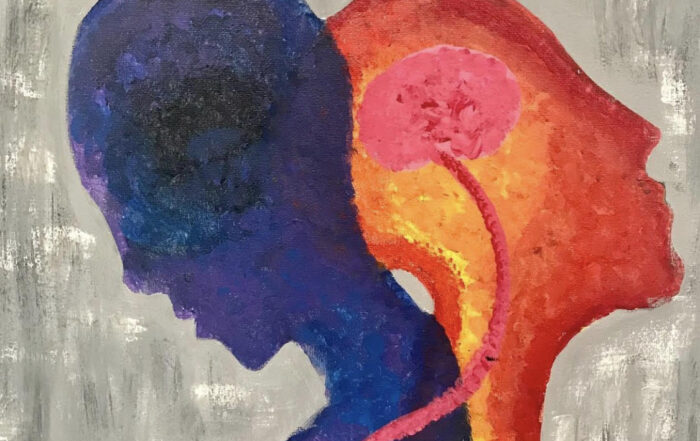
By- Saesha Sharda, Freshman, 2020 “Life doesn’t make any sense without interdependence. We need each other, and the sooner we learn that the better for us all.” — Erik Erikson In the present artwork, I have chosen to write focuses on the struggles of having bipolar disorder. Bipolar disorder is a mental illness characterized by extreme swings of high and low moods. The high mood is known as the manic phase, and the low mood is known as the depressive phase(“Bipolar Disorder: Symptoms, Causes, Diagnosis, Treatment.”). In my painting, I have shown two human-resembling figures balancing on each others’ backs, connected by the brain and heart. One figure is blue and has a heart painted on its chest. This figure represents the depressive phase, as blues and purples usually represent sad, somber moods. The other figure, which is yellow and has a brain painted in its head, represents the manic phase, as we normally pair the color yellow with high energy. The reason the heart and brain are shown is to represent their connection: Rational thinking (the brain) and Emotions (the heart). The figures are part of the same person, symbolizing how the two phases occur to the same person, affecting the same person, making it especially hard to get through daily life. The reason I wanted to create this painting was that I am passionate about raising awareness about not only bipolar disorder, but mental health issues in general. It is so important that we spread the word about mental illnesses and coping with them so that we can break the stigma that surrounds them. Stigma is a word to describe the social disapproval or discrimination against a person based on their characteristics, physical or mental. It is the fear of the stigma that keeps people suffering from mental health issues from coming forward about their struggles. In the Indian community especially, stigma against mental health issues is very apparent. The more we talk about it, the closer we are to helping someone cope with their mental illness and even saving lives. Submitting my painting to Vosap’s International Competition about disabilities was the perfect opportunity to share my art, and spread awareness about mental health issues. Work Cited: “Bipolar Disorder: Symptoms, Causes, Diagnosis, Treatment.” WebMD, WebMD, www.webmd.com/bipolar-disorder/mental-health-bipolar-disorder#:~:text=Bipolar%20disorder%2C%20also%20known%20as,sad%2C%20hopeless%2C%20and%20sluggish.
Periodt…! periods are not our weaknesses, but our strengths
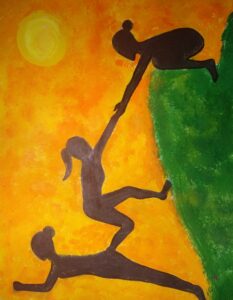
By -Saesha Sharda, Grade 9th When I was a little girl, I was not really encouraged to talk about menstruation, especially in front of my older family members and relatives. Not only was I confused about why periods occur, but also why I wasn’t allowed to talk about it. Now that I’m older and know about periods, I can comfortably talk about them with my parents whenever I have questions or concerns. Menstruation is a fascinating process that happens to almost every single woman on the planet, and I don’t understand why women get shunned for talking about it. Periods are not ‘gross’ or ‘weird’, they’re pretty cool. We need to empower women and encourage them to stand up and talk about light-hearted things like periods, to other heavier topics. My artwork on women empowerment ties into the concept of women helping women. In my artwork, I have shown three women helping each other climb a cliff through a fire. The cliff represents the normal hardships women have to go through, and the fire represents how the outside world makes it harder for women to achieve these tasks. I have used acrylic paint to show a silhouette of the women the background is with acrylic textures. It is important we address things like this through artforms for expressions, I feel it is a step in the right direction. Women are awesome! But, I do understand that the older generation was raised to not talk about women’s’ issues and menstruation, but it is time that changes. Our periods are not our weaknesses, but our strengths; and it’s pretty cool that we get to go through this cycle that perpetuates the entire human species!
Haunted Scene – Op Art
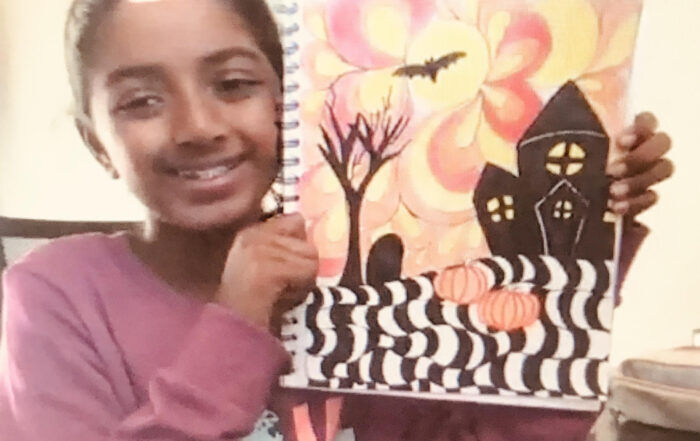
By Saira Siraj This is a Halloween drawing which includes a headstone, haunted house, pumpkins, cemetery, bats, and a tree. On the floor of this artwork, I used an op art technique to create wave-like illusions. In the sky are shapes that are like petals and I colored them with warm colors, red, yellow and orange. The technique that is used in this, is called Op Art. Op Art is short for optical art. Op art is when something is drawn on a piece of paper or on canvas and it looks like it’s moving because their eyes are following the lines. Some famous Op art artists were Vincent Vasarely and Bridget Riley. We first started off by sketching out the haunted house and the main items, such as the tree and the bat. Then we outlined everything as in Sharpie and afterwards, I started making wavy lines on the floor for the optical illusion then we made curves in the waves. Then, I colored every other section to make an alternate pattern. Then, in the sky I made lots of petal shapes coming out of the moon and colored them in the pattern yellow, orange, and red. Then I colored in the windows of the Haunted House yellow and colored everything else in with Sharpie.
Desert Landscape Watercolor Painting
By: Apoorva Kulshreshtha For the month of September, we focused on landscape art work and watercolors. In the painting that I painted, there is a background of a desert with a silhouette of camel and some cacti. The drawing is of an evening sky with the sun that is setting. We learned about how to draw the basic outline of a camel and coloring a sky with watercolors. My favorite part about this artwork was the camel. In 200 AD, camels started to be of use in the Sahara Desert. They carry goods across the Trans-Saharan trade routes. Most of them carried salt, cotton, tea, gold, etc. People used camels because they would dwell in harsh weather and stay without water and food for a long time. People who live in the desert rely on camels for their milk, meat, and fur. For the artwork, we had to mix several colors to get the right colors of the sky. I am proud of how my painting turned out.
My Art experience with disability
By;Aashna Singh In the month of July, my art class decided to do the art project for an international art competition as a disability project under VOSAP. I picked a blind girl with a service dog, the other kids who were in my art class, which was my brother and my cousin, did a color-blind person and a wheelchair person. I picked a service dog because I have a dog at home even though he’s not a service dog he is still part of the working dog category, sledding is not a connection with a service dog some people say but I say sledding is still a fine connection with a sledding dog. I picked a blind girl because blind really has a thing to it, it makes lots of people think about how blind people think like so: what would a blind person see as their family or how do they read? And, how do they understand how to read if they can’t see? How can they learn? Blind people have tough lives. When I was drawing this art project I found a connection. My favorite book series is called Wings Of Fire (WOF) a character from that got blind but learned how to fly dodge trees and know the whole RainWing kingdom. Of Course, it’s just a book. But learning how to do that is just so tough. At my old school, there were these dots that are called Braille. It is 3D and it’s a kind of language so at my school each classroom will have that to help the blind. I felt happy when I submitted my artwork to VOSAP I knew I would never win considering how GOOD my brother was. But still, it was a good feeling to submit it.
Aurora, Magic of Colors
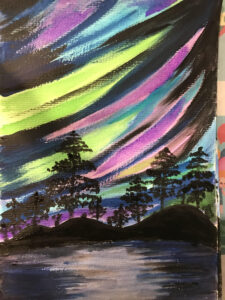
By- Aarav Singh Today I am going to be talking about my artwork based on the Northern Lights, also known as an Aurora. This is the artwork that I did for the fourth week of July 2020, Yes while we all are shelter in place because of COVID 19 Pandemic. I found this artwork inspiring because it shows how beauty can be found anywhere, even in the desolate northern and southern poles. While doing this artwork I was reminded about how many otherworldly phenomena there are on earth. I feel like Auroras are something you have to see yourself to truly believe that they are real. An odd way I’ve thought about Auroras is that they’re like big neon markers that have been drawn in swirls around the sky. Aurora is a natural light display typically found in high-latitude regions and is caused by disturbances in the magnetosphere from solar lights. Typically the magnetosphere keeps most solar lights out, but occasionally some solar lights get in. The atoms in the solar light get excited and once they reach a lower energy state they release a photon: light. These lights create an Aurora. Auroras come in many different colors including; blue, pink, purple, and red. Although Auroras come in all these colors they are most commonly green. Aurora’s are some of the most beautiful and fascinating occurrences in the world. I really enjoyed doing my Aurora project because of the beauty that it has to it and the simpleness. It was an easy project yet it was still alluring. Aurora has always fascinated me and they continue to. For this Project I used Water colors splash and spread technique on paper.
Rani Padmavati, Legend of Honor and Patriotism
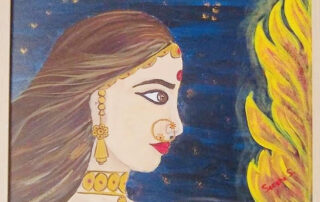
By Saesha Sharda For centuries, women have been underestimated, cast down compared to men, and even ridiculed. Though some change has taken place, sexism towards women still exists. Over the years, women have risen to power by peaceful protesting, hunger strikes, and much more. In fact, the year 2020 celebrates one hundred years of women’s right to vote in America. I wanted to create an artwork showcasing women empowerment. Rani Padmavati is a celebrated Indian icon for women empowerment. Padmavati along with her husband, Ratan Sen, ruled the Mewar Kingdom. Soon after their marriage, a power-hungry king named Allauddin Khilji attacked the Mewar Kingdom. Unfortunately, Ratan Sen was killed during the battle. Padmavati did not want to live under another king’s rule, with a risk of losing her honor or dignity. So, she, along with many other women, jumped into an open pit of fire. Padmavati is a symbol of women’s empowerment because she protected her dignity. In my painting, Padmavati is shown walking confidently into the flames depicts dignity, pride, and values for the motherland…come what may!. It is a reflection of Indian Rajput women preferring their honor in defending their kingdom and dignity against invader Alauddin Khalji.
Hand Dexterity still relevant for highly specialized professions
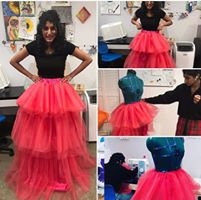
Hand or Manual dexterity is the ability to use your hands in a skillful, coordinated way to grasp and manipulate objects and demonstrate small, precise movements. As per Dr. Roger Kneebone about a worrisome issue affecting medical students in the UK: They show a lack of hand dexterity in simple tasks such as tying knots and cutting string. Hand dexterity is a critical skill for surgeons, yet “It seems we can no longer rely on people having developed these ways of using their hands from early childhood, at home, and at school,” ( https://activeforlife.com/developing-hand-dexterity-in-early-years-essential-for-adulthood/) Experts have suggested that this ineptitude in fine motor skills among the current generation of emerging clinicians and many more professionals may be due to less exposure to knowledge and learning that require practical drawing and craft skills in primary and secondary schools. Dr. Rhea Liang, MBChB, an Associate professor of Surgery specializing in breast cancer at Gold Coast Hospital and Health Service in Robina, Australia, does “wool craft” during lectures to help her listen to and recall information. (The ‘Knitting Lady’ Is a Surgeon and She’s Paying Attention “Unlike Phones, Handiwork Does Not Distract” by-Nick Mulcahy, August 12, 2019, https://www.medscape.com/viewarticle/916712) At present increasing numbers of young kids are just using a keyboard for 90% of their work. they hardly use their thumb for their academic tasks. Using hand and handheld tools for Geometry, Art, writing skills focus on cursive writing, hand embroidery is, becoming obsolete and are no longer mandatory either in schools or at home as a part of the personality growth. Regardless of ability, activities, and skills that focus on dexterity and fine motor skills are important because they help students increase the muscles in their fingers, hands, and wrists, while also increasing coordination. Engaging in skills like embroideries, sewing, cutting, painting, drawing in early life does not necessarily mean that you are going to be a fashion or textiles designer, or, professional in a related field. But, it nurtures your ability to become efficient in certain skills that require high precision, hand-eye coordination, and application of fine motor skills like performing surgery, as quoted earlier. More and more schools are looking into these abilities apart from your perfect score in your academia. Yes! The Dental Admission Test (DAT) contains a section that specifically tests this skill, and during on-campus interviews, most dental school admissions staff will ask you to discuss how you’ve developed your manual dexterity skills. At Kalaa You will get the opportunity to nurture this part of your persona and will help to engage the students creatively and refine their needed skills for the future. These developed portfolios can be used towards college admission : Art Portfolio (3 years Learning skills culminating to Art Portfolio for school admission as Extracurricular activity for a length of time) Painting Exhibition Foundation of Textiles and Fashion Design (2 years Designing/ pattern development/sewing)Needlecraft (2 Years) Blog writing to support your comprehension skills and explanatory ability As the 🌎 stops, hit the gas on! Building your art profile getting access to a unique, personalized training that will bring out the best in you! Shelter in Place, Social distancing is the key! Stay safe, keep your spirits high! Online classes for #Art and #Design Portfolio development for c

